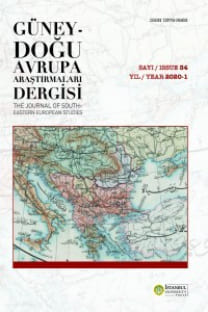İmparator Tiberios Konstantinos Döneminde Balkanlarda Doğu Roma- Avar İlişkileri (572- 582)
Doğu Roma, Bizans, Avar, Slav, Tiberios Konstantinos
Eastern Roman and Avar Relations in the Balkans During the Reign of Emperor Tiberius II Constantine (572- 582)
Eastern Roman, Byzantine, Avars, Slavs, Tiberius II Constantine,
___
- Ahmetbeyoğlu, Ali, Sorularla Eski Türk Tarihi, İstanbul: Yeditepe Yayınevi, 2015.
- Brown, Peter, Geç Antikçağ Dünyası, çev. Turhan Kaçar, İstanbul: Alfa Yayınları, 2017.
- Bury, John Bagnell, A History of the Later Roman Empire- From Arcadius to Irene, London: Macmillan and Co, 1889.
- Bury, John Bagnell, Barbarların Avrupa’yı İstilası, çev. İslam Kavas, Yusuf Akbaba, İstanbul: Kronik Yayınları, 2020.
- Ceceli Dursun, Gülseren, “İran’da İpek Yolu ve Türkmenler”, İpek Yolu, (İstanbul 2015), s. 349- 362.
- Curta, Florin, Slavs in the Making History, Linguistics and Archaeology in Eastern Europe (ca. 500- ca. 700), London: Routledge, 2021.
- Demirkent, Işın, “14. Yüzyıla kadar Balkanlarda Bizans Hakimiyeti”, Bizans Tarihi Yazıları, İstanbul: Dünya Yayınları, 2005, s. 17- 30.
- Demirkent, Işın, “Bizans”, TDV İslam Ansiklopedisi, VI.
- Evagrius Scholasticus, The Ecclesiastical History of Evagrius Scholasticus, çev. Michael Whitby, Liverpool University Press, Liverpool 2000.
- Evans, James Allan Stewart, The Age of Justinian- The Circumstances of Imperial Power, London: Routledge, 2000.
- Fine Jr, John Van Antwerp, Early Medieval Balkans- A Critical Survey from the Sixth to the Late Twelfth Century, Ann Arbor: University of Michigan Press, 1991.
- Gibbon, Edward, Roma İmparatorluğu’nun Gerileyiş ve Çöküş Tarihi, çev. Asım Baltacıgil, Meral Harzem, V, İstanbul: Indie Yayınları, 2020.
- Gregorius Turonensis, Gregory of Tours- The History of The Franks, çev. Lewis Thorpe, Penguin Classics, London 1974.
- Gregory, Timothy E., Bizans Tarihi, çev. Esra Ermert, İstanbul: Yapı Kredi Yayınları, 2019.
- Haldon, John, Bizans Tarihi Atlası, çev. Ali Özdamar, İstanbul: Alfa Tarih Yayınları, 2017.
- Heršak, Emil, “Avarlar: Etnik Yaradılış ve Tarihlerine Bir Bakış”, Türkler Ansiklopedisi, II, s. 641- 657.
- Heyd, Wilhelm, Yakın- Doğu Ticaret Tarihi, çev. Enver Ziya Karal, Ankara: Türk Tarih Kurumu Yayınları, 2000.
- Ioannes Ephesi, The Third Part of the Ecclesiastical History of John Bishop of Ephesus, çev. R. Payne Smith, III, Oxford University Press, Oxford 1860.
- Jones, Arnold Hugh Martin, Later Roman Empire- 284- 602, Oxford: Basil Blackwell, 1964.
- Kaegi, Walter Emil, “Tiberios I”, The Oxford Dictionary of Byzantium, III.
- Kaegi, Walter Emil, Kazhdan, Alexander, “Baian”, The Oxford Dictionary of Byzantium, I.
- Kaegi, Walter Emil, Kazhdan, Alexander, Cutler, Anthony, “Justinian I”, The Oxford Dictionary of Byzantium, II.
- Kardaras, Georgios, Byzantium and The Avars 6th-9th Century AD: Political, Diplomatic and Cultural Relations, Leiden-Boston: Brill, 2018.
- Kazhdan, Alexander, “Sirmium”, The Oxford Dictionary of Byzantium, III.
- Kurat, Akdes Nimet, IV- XVIII. Yüzyıllarda Karadeniz Kuzeyindeki Türk Kavimleri ve Devletleri, Ankara: Türk Tarih Kurumu Yayınları, 2019.
- Küçüksipahioğlu Birsel, “Bizans İmparatoru Iustinianos Döneminde (527-565) İstanbul”, Tarih İçinde İstanbul Uluslararası Sempozyumu, 11-17 Aralık 2010, Bildiriler, İstanbul 2011, s. 157-167.
- Küçüksipahioğlu, Birsel, “Ankhialos Savaşı’nın Sonuna Kadar Bizans-Bulgar İlişkileri”, Güneydoğu Avrupa Araştırmaları Dergisi, XIV, (İstanbul 2009), s. 209- 226.
- Küçüksipahioğlu, Birsel, “Bizans İmparatorluğu Tarihine Genel Bir Bakış”, Doğu’dan Batı’ya Düşüncenin Serüveni- Antikçağ Yunan Düşüncesi, Ortaçağ Düşüncesi, İstanbul: İnsan Yayınları, 2015, s. 525- 553.
- Leeper, Allen, “Germans, Avars and Slavs”, The Slavonic and East European Review, XII/ 34, (1933), s. 117- 132.
- Liebeschuetz, Wolf, East and West in Late Antiquity, Leiden: Brill, 2015.
- Maas, Michael, “How the Steppes Became Byzantine: Rome and the Eurasian Nomads in Historical Perspective”, Empires And Exchanges in Eurasian Late Antiquity, Cambridge: Cambridge University Press, 2018, s. 19- 34.
- Mango, Cyril, Bizans- Yeni Roma İmparatorluğu, çev. Gül Çağalı Güven, İstanbul: Yapı Kredi Yayınları, 2018.
- Martindale, John Robert, “Tiberius Constantinus”. The Prosopography of Later Roman Empire, III- B.
- Menandros Protiktor, The History of Menander the Guardsman, çev. Roger C. Blockley, Francis Cairns Publications, Liverpool 1985.
- Mitchell, Stephen, Geç Roma İmparatorluğu Tarihi- M.S. 284-641, çev. Turhan Kaçar, Ankara: Tarih Kurumu Yayınları, 2016.
- Norwich, John Julius, Bizans- Erken Dönem (MS 323- 802), çev. Hamide Koyukan, İstanbul: Kabalcı Yayınevi, 2013.
- Ostrogorsky, Georg, Bizans Devleti Tarihi, çev. Fikret Işıltan, Ankara: Türk Tarih Kurumu Yayınları, 2015.
- Pohl, Walter, The Avars- A Steppe Empire in Central Europe 567- 822, Ithaka: Cornell University Press, 2018.
- Preiser-Kapeller, Johannes, “The Climate of the Khagan. Observations on Palaeoenvironmental Factors in the History of the Avars (6th-9th Century)”, Lebenswelten zwischen Archäologie und Geschichte- Festschrift für Falko Daim zu seinem 65. Geburtstag, (Mainz 2018), s. 311- 324.
- Sarantis, Aleksander, “East Roman Management of Barbarians Tribes in the Lower-Middle Danube Frontier
- Zones, AD 332-610”, GrenzÜbergänge: Forschungen zu Spätantike und Mittelalter, Verlag Bernhard Albert Greiner, (Rahden 2017), s. 41- 66.
- Theophanes Homologetes, The Chronicle of Theophanes Confessor-Byzantine and Near Eastern History AD 284-813, çev. Cyril Mango, Roger Scott, Clarendon Press, Oxford 1997.
- Whittow, Mark, “Byzantium’s Eurasian Policy in the Age of the Turk Empire”, Empires And Exchanges in Eurasian Late Antiquity, Cambridge: Cambridge University Press, 2018, s. 271- 286.
- ISSN: 0378-3863
- Başlangıç: 1974
- Yayıncı: İstanbul Üniversitesi
Üsküp’de Bir Osmanlı Mutasarrıfı: Ali Hıfzî Paşa ve Bardovça’daki Konağı
İstanbul Latin İmparatorluğu’nun Kuruluş Sürecinde II. Bulgar Krallığı ile Mücadelesi (1204-1207)
İmparator Tiberios Konstantinos Döneminde Balkanlarda Doğu Roma- Avar İlişkileri (572- 582)
Metin USLU, Gülseren CECELİ DURSUN
1878 Berlin Antlaşmasının Diplomasi Siyasetine Etkisinin Analizi
Savaşın Tatbiki: 1860 ve 70'li yıllarda Rusya ve Osmanlı’nın Reformları ve Silahlı Kuvvetleri
Rus Arşiv Kaynaklarına Göre Bir Ukrayna Kazak Hetmanı: İvan Stepanovıç Mazepa (1639-1709)
